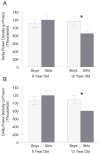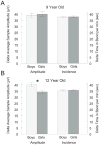Sleep EEG evidence of sex differences in adolescent brain maturation
- PMID: 16171278
- PMCID: PMC2596759
- DOI: 10.1093/sleep/28.5.637
Sleep EEG evidence of sex differences in adolescent brain maturation
Abstract
Study objectives: The steep decline in slow-wave (delta) electroencephalogram (EEG) intensity across adolescence is a prominent feature of late brain maturation. As a first step in determining whether the adolescent delta decline is similar in both sexes, we compared cross-sectional sleep EEG data from 9- and 12-year-old boys and girls.
Design: All-night EEG recordings, 6 months apart, were conducted on each subject.
Setting: EEG was recorded in the subjects' homes.
Participants: Thirty-two 9-year-olds and 38 12-year-olds are enrolled in a 4-year longitudinal study of adolescent sleep. There are equal numbers of each sex in both age cohorts.
Interventions: N/A.
Measurements: Using ambulatory recorders, EEG was recorded in the subjects' homes on their normal sleep schedule. For each of the 2 semi-annual recording periods, data from the 10 subjects from each age-sex group with the cleanest (fewest artifacts) signals were selected for crosssectional comparisons of visual scoring and EEG variables. All artifact-free 20-second non-rapid eye movement epochs were analyzed with power spectral and period-amplitude analysis.
Results: In the 12-year-old cohort, delta power per minute was 37% higher in boys than girls. The 9-year-old cohort showed no sex difference. A second recording 6 months later produced similar results.
Conclusion: These cross-sectional data indicate that girls begin the steep adolescent decline in slow-wave EEG earlier than boys. We hypothesize that this reflects an earlier onset of adolescent synaptic pruning in females.
Conflict of interest statement
Disclosure Statement
This was not an industry supported study. Drs. Campbell, Darchia, Khaw, Higgins, and Feinberg have indicated no financial conflicts of interest.
Figures



References
-
- Feinberg I, Hibi S, Carlson VR. Changes in EEG amplitude during sleep with age. In: Nandy K, Sherwin I, editors. The Aging Brain and Senile Dementia. New York: Plenum Press; 1977. pp. 86–98.
-
- Feinberg I, Carlson VR. Sleep variables as a function of age in man. Arch Gen Psychiatr. 1968;18:239–50.
-
- Feinberg I, March JD, Flach K, Maloney T, Chern W-J, Travis F. Maturational changes in amplitude, incidence and cyclic pattern of the 0 to 3 Hz (delta) electroencephalogram of human sleep. Brain Dysfunction. 1990;3:183–92.
-
- Coble PA, Reynolds CF, III, Kupfer DJ, Houck P. Electroencephalographic sleep of healthy children. Part II: Findings using automated delta and REM sleep measurement methods. Sleep. 1987;10:551–62. - PubMed
-
- Feinberg I. Schizophrenia: caused by a fault in programmed synaptic elimination during adolescence? J Psychiatr Res. 198283;17:319–34. - PubMed
Publication types
MeSH terms
Grants and funding
LinkOut - more resources
Full Text Sources
Medical
Research Materials

